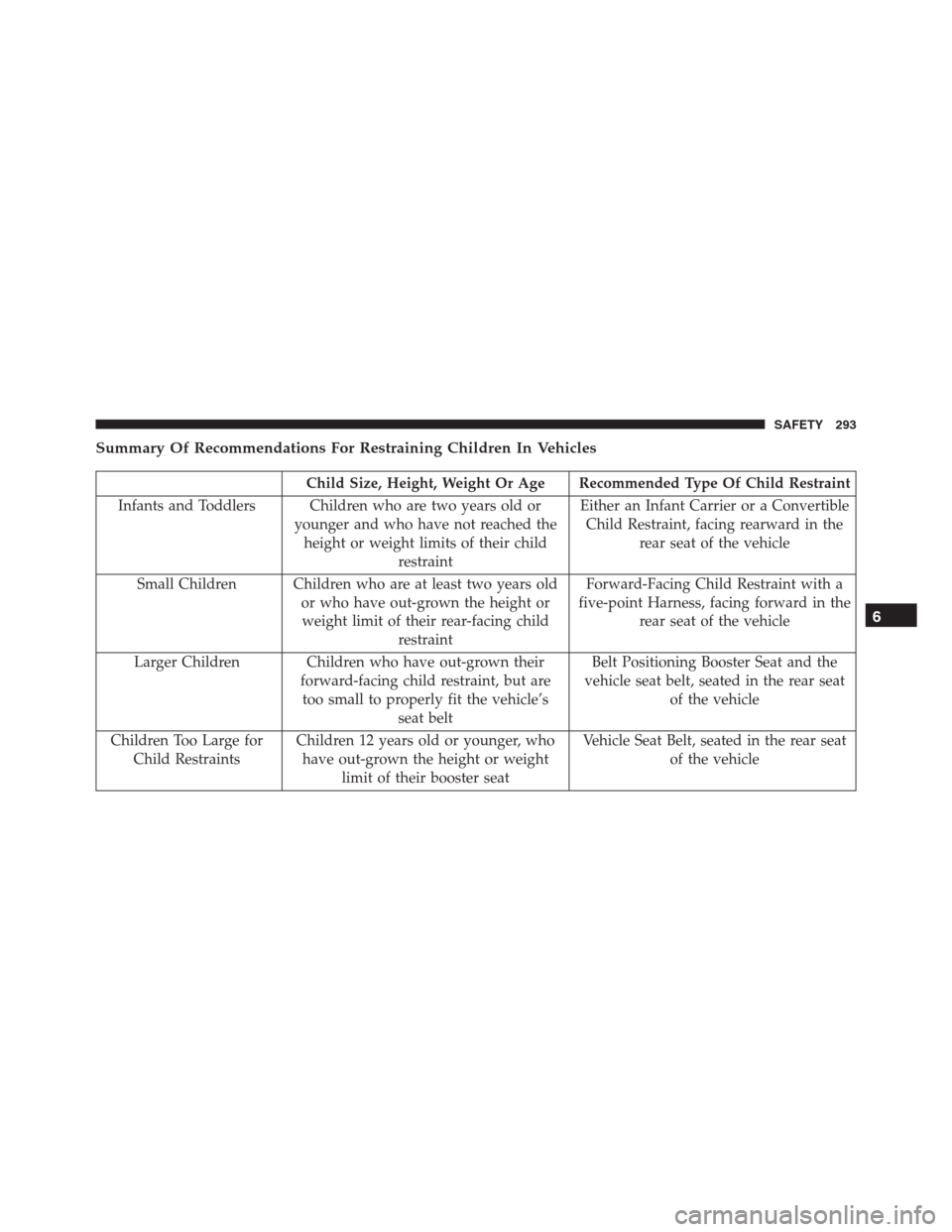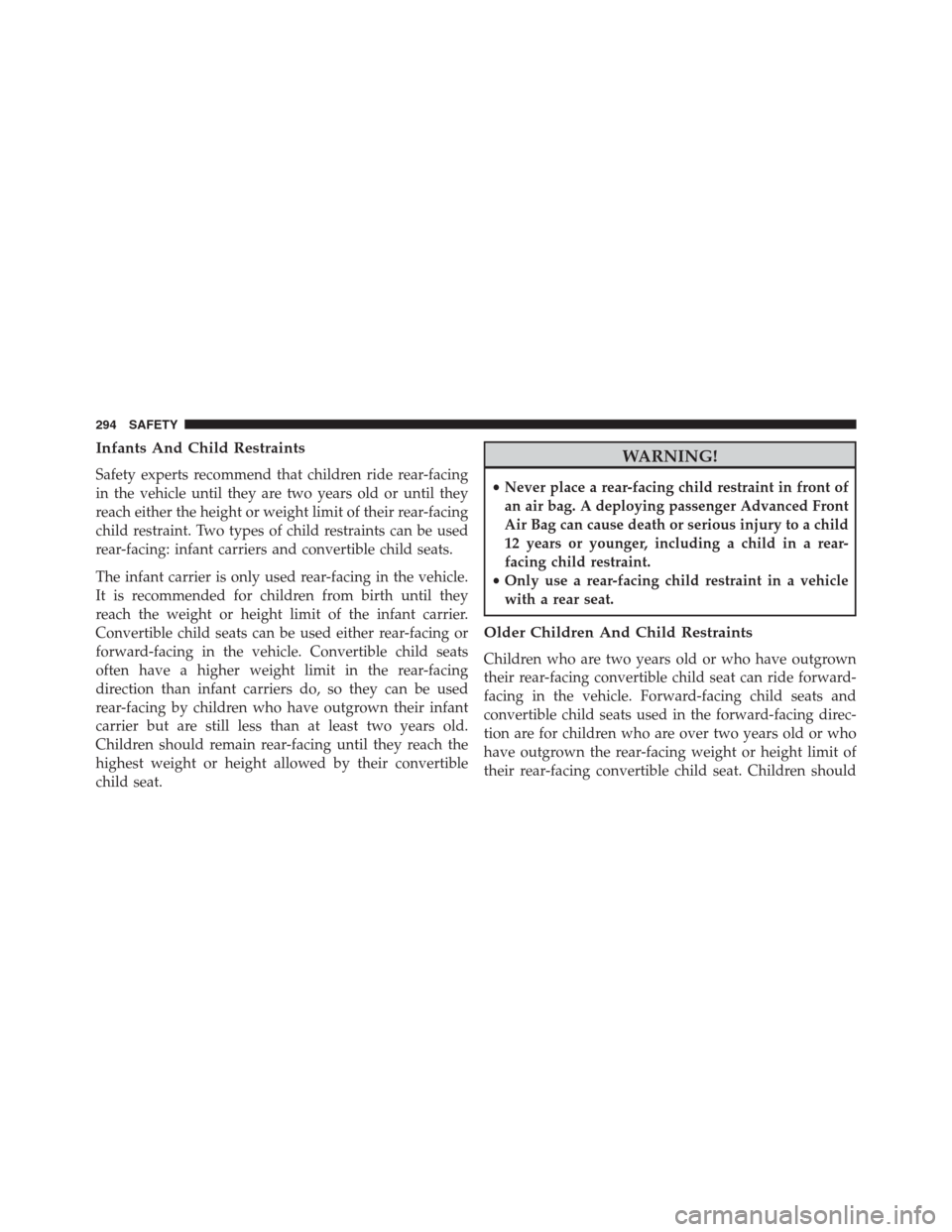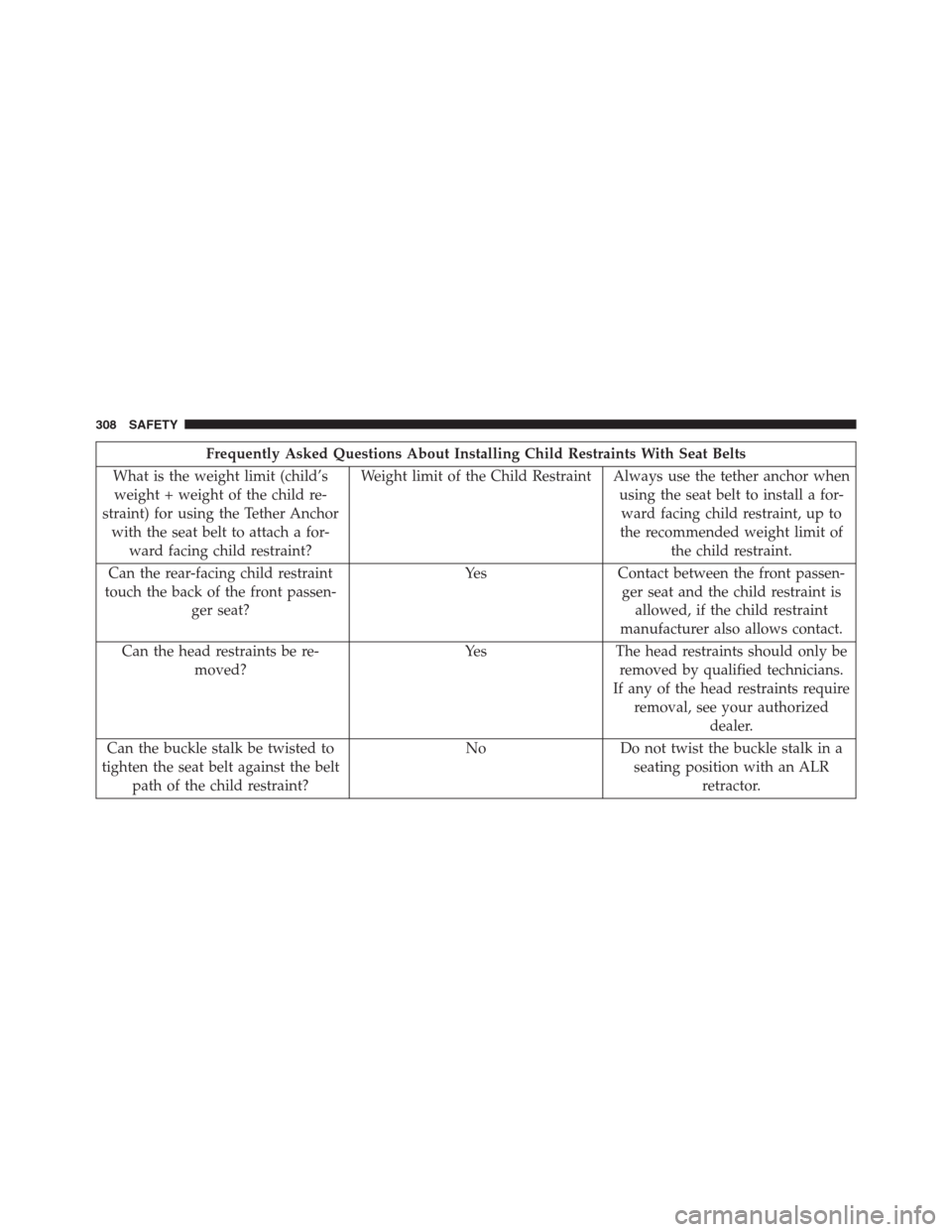Page 165 of 688
NOTE:The cargo box is sized for a maximum capacity of
distributed weight equal to 242 lbs (110 kg).
INTERNAL EQUIPMENT
Glove Compartment
The glove compartment is located on the passengers side
of the instrument panel.
To open the glove compartment proceed as follows:
1. Unlock the compartment using the vehicle key.
2. Pull the handle to open the compartment.
Once the glove compartment is open, a light will turn on
to illuminate the compartment.
Opening The Glove Compartment
1 — Glove Compartment Handle
4
GETTING TO KNOW YOUR VEHICLE 163
Page 259 of 688

NOTE:TSC cannot stop all trailers from swaying. Al-
ways use caution when towing a trailer and follow the
trailer tongue weight recommendations. Refer to “Trailer
Towing” in this section for further information. When
TSC is functioning, the “ESC Activation/Malfunction
Indicator Light” will flash, the engine power may be
reduced and you may feel the brakes being applied to
individual wheels to attempt to stop the trailer from
swaying. TSC is disabled when the ESC system is in the
“Partial Off” mode.
WARNING!
If TSC activates while driving, slow the vehicle
down, stop at the nearest safe location, and adjust the
trailer load to eliminate trailer sway.
Dynamic Steering Torque (DST)
The DST function uses the integration of the ESC system
with the electric power steering to increase the safety
level of the whole car. In critical situations (understeer-
ing, oversteering, braking with different grip conditions),
through the DST function the ESC system controls the
steering to implement an additional torque contribution
on the steering wheel, to suggest the most correct ma-
neuver to the driver. The coordinated action of brakes
and steering increases the safety and car control feeling.
NOTE:The DST is a driving aid system and does not
replace the driver ’s actions while driving the car.
6
SAFETY 257
Page 295 of 688

Summary Of Recommendations For Restraining Children In Vehicles
Child Size, Height, Weight Or Age Recommended Type Of Child Restraint
Infants and Toddlers Children who are two years old or
younger and who have not reached the
height or weight limits of their child
restraintEither an Infant Carrier or a Convertible
Child Restraint, facing rearward in the
rear seat of the vehicle
Small Children Children who are at least two years old
or who have out-grown the height or
weight limit of their rear-facing child
restraintForward-Facing Child Restraint with a
five-point Harness, facing forward in the
rear seat of the vehicle
Larger Children Children who have out-grown their
forward-facing child restraint, but are
too small to properly fit the vehicle’s
seat beltBelt Positioning Booster Seat and the
vehicle seat belt, seated in the rear seat
of the vehicle
Children Too Large for
Child RestraintsChildren 12 years old or younger, who
have out-grown the height or weight
limit of their booster seatVehicle Seat Belt, seated in the rear seat
of the vehicle
6
SAFETY 293
Page 296 of 688

Infants And Child Restraints
Safety experts recommend that children ride rear-facing
in the vehicle until they are two years old or until they
reach either the height or weight limit of their rear-facing
child restraint. Two types of child restraints can be used
rear-facing: infant carriers and convertible child seats.
The infant carrier is only used rear-facing in the vehicle.
It is recommended for children from birth until they
reach the weight or height limit of the infant carrier.
Convertible child seats can be used either rear-facing or
forward-facing in the vehicle. Convertible child seats
often have a higher weight limit in the rear-facing
direction than infant carriers do, so they can be used
rear-facing by children who have outgrown their infant
carrier but are still less than at least two years old.
Children should remain rear-facing until they reach the
highest weight or height allowed by their convertible
child seat.
WARNING!
•Never place a rear-facing child restraint in front of
an air bag. A deploying passenger Advanced Front
Air Bag can cause death or serious injury to a child
12 years or younger, including a child in a rear-
facing child restraint.
•Only use a rear-facing child restraint in a vehicle
with a rear seat.
Older Children And Child Restraints
Children who are two years old or who have outgrown
their rear-facing convertible child seat can ride forward-
facing in the vehicle. Forward-facing child seats and
convertible child seats used in the forward-facing direc-
tion are for children who are over two years old or who
have outgrown the rear-facing weight or height limit of
their rear-facing convertible child seat. Children should
294 SAFETY
Page 297 of 688

remain in a forward-facing child seat with a harness for
as long as possible, up to the highest weight or height
allowed by the child seat.
All children whose weight or height is above the
forward-facing limit for the child seat should use a
belt-positioning booster seat until the vehicle’s seat belts
fit properly. If the child cannot sit with knees bent over
the vehicle’s seat cushion while the child’s back is against
the seatback, they should use a belt-positioning booster
seat. The child and belt-positioning booster seat are held
in the vehicle by the seat belt.
WARNING!
•Improper installation can lead to failure of an
infant or child restraint. It could come loose in a
collision. The child could be badly injured or
killed. Follow the child restraint manufacturer ’s
(Continued)
WARNING!(Continued)
directions exactly when installing an infant or
child restraint.
•After a child restraint is installed in the vehicle, do
not move the vehicle seat forward or rearward
because it can loosen the child restraint attach-
ments. Remove the child restraint before adjusting
the vehicle seat position. When the vehicle seat has
been adjusted, reinstall the child restraint.
•When your child restraint is not in use, secure it in
the vehicle with the seat belt or LATCH anchor-
ages, or remove it from the vehicle. Do not leave it
loose in the vehicle. In a sudden stop or accident, it
could strike the occupants or seatbacks and cause
serious personal injury.
6
SAFETY 295
Page 299 of 688
Recommendations For Attaching Child Restraints
Restraint Type Combined
Weight of the
Child + Child
RestraintUse any attachment method shown with an “X” Below
LATCH –
Lower Anchors
OnlySeat Belt Only LATCH –
Lower Anchors
+ Top Tether
AnchorSeat Belt + Top
Tether Anchor
Rear-Facing
Child RestraintUp to 65 lbs
(29.5 kg)XX
Rear-Facing
Child RestraintMore than
65 lbs (29.5 kg)X
Forward-Facing
Child RestraintUp to 65 lbs
(29.5 kg)XX
Forward-Facing
Child RestraintMore than
65 lbs (29.5 kg)X
6
SAFETY 297
Page 302 of 688
Frequently Asked Questions About Installing Child Restraints With LATCH
What is the weight limit (child’s weight
+ weight of the child restraint) for using
the LATCH anchorage system to attach
the child restraint?65 lbs (29.5 kg) Use the LATCH anchorage system until
the combined weight of the child and the
child restraint is 65 lbs (29.5 kg). Use the
seat belt and tether anchor instead of the
LATCH system once the combined
weight is more than 65 lbs (29.5 kg).
Can the LATCH anchorages and the seat
belt be used together to attach a rear-
facing or forward-facing child restraint?No Do not use the seat belt when you use
the LATCH anchorage system to attach a
rear-facing or forward-facing child
restraint.
Can a child seat be installed in the center
position using the inner LATCH lower
anchorage?No Use the seat belt and tether anchor to
install a child seat in the center seating
position.
300 SAFETY
Page 310 of 688

Frequently Asked Questions About Installing Child Restraints With Seat Belts
What is the weight limit (child’s
weight + weight of the child re-
straint) for using the Tether Anchor
with the seat belt to attach a for-
ward facing child restraint?Weight limit of the Child Restraint Always use the tether anchor when
using the seat belt to install a for-
ward facing child restraint, up to
the recommended weight limit of
the child restraint.
Can the rear-facing child restraint
touch the back of the front passen-
ger seat?Yes Contact between the front passen-
ger seat and the child restraint is
allowed, if the child restraint
manufacturer also allows contact.
Can the head restraints be re-
moved?Yes The head restraints should only be
removed by qualified technicians.
If any of the head restraints require
removal, see your authorized
dealer.
Can the buckle stalk be twisted to
tighten the seat belt against the belt
path of the child restraint?No Do not twist the buckle stalk in a
seating position with an ALR
retractor.
308 SAFETY